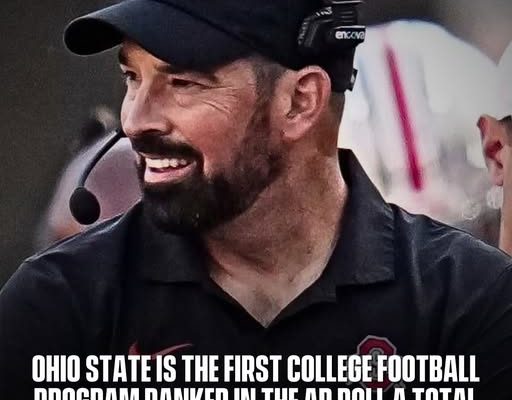A thousand times at the top isn’t just a number—it’s a legacy. For Ohio State football, the achievement of becoming the first college program to reach 1,000 appearances in the Associated Press Poll represents more than a statistical milestone. It is the embodiment of decades of dominance, consistency, and excellence, a living history written in Scarlet and Gray across generations of players, coaches, and fans. The Buckeyes have not only built one of the most successful programs in college football history but have sustained that success through eras of change, challenge, and evolution in the sport. Standing nearly 100 rankings ahead of any other team, Ohio State’s position is not just secure—it is towering.
When the AP Poll debuted in 1936, college football was already deeply woven into the American cultural fabric, but few could have predicted the rise of dynasties that would come to define the sport. For Ohio State, those early decades laid the foundation of a program that would soon become synonymous with winning. Woody Hayes arrived in 1951 and brought with him an uncompromising philosophy: toughness, discipline, and the relentless pursuit of excellence. Hayes was more than a coach; he was a figure who embodied the spirit of Ohio itself—hardworking, uncompromising, and deeply proud. Under his leadership, Ohio State not only won national championships but also carved an identity that continues to define the program today. It was during the Hayes years that Ohio State became a regular fixture in the AP Poll, often representing the standard by which other programs measured themselves.
The poll appearances tell a story of dominance across decades. Few programs in any sport have been able to sustain relevance across so many generations. From the days of three-yards-and-a-cloud-of-dust football to the modern spread offenses that define the game today, Ohio State has not only adapted but thrived. Coaches have changed, styles have shifted, and the sport itself has evolved in ways Hayes could never have imagined, yet the Buckeyes have remained constant. This speaks to something deeper than strategy or talent; it speaks to a culture. The Ohio State culture is one of expectation—expectation to win, to compete at the highest level, and to carry forward a tradition that is larger than any individual. Every player who steps onto the field at Ohio Stadium understands that they are part of something enduring, something that has been built brick by brick, game by game, ranking by ranking.
The AP Poll is often criticized for its subjectivity, for being influenced by reputation and perception as much as results. Yet it is precisely reputation and perception that Ohio State has mastered. For nearly nine decades, the Buckeyes have commanded respect on the field and in the polls, not because of hype but because of sustained performance. Even in seasons of transition or disappointment, Ohio State rarely slips far. That resilience is what makes the 1,000-mark so significant. It is not about a single golden era; it is about many golden eras strung together, creating a tapestry of excellence that few others can match. Programs may rise and fall, have their flashes of dominance, and then fade. Ohio State has never faded. The Buckeyes are always there, always in the conversation, always on the front page of college football’s story.
From the perspective of fans, this milestone is as much theirs as it is the program’s. Ohio State football is not just a Saturday ritual; it is a generational bond. Families pass down season tickets, grandparents tell stories of games past, and children grow up dreaming of running out of the tunnel at the Horseshoe. To say the Buckeyes have been ranked 1,000 times is to say that they have been part of the lives of countless Ohioans for decades, offering moments of joy, heartbreak, triumph, and pride. Each poll appearance represents not just a number in a column but a memory: a win over Michigan, a championship run, a Heisman Trophy campaign, a Saturday night under the lights. The rankings are markers in a shared history between the team and its fans, a history that grows richer with every passing season.
Consider the pantheon of coaches who have carried the torch. After Hayes came Earle Bruce, who maintained competitiveness. Then John Cooper, who brought talent but often fell short in rivalry games. Jim Tressel restored championship glory, leading the Buckeyes to a national title in 2002 and ensuring Ohio State was a regular in the BCS era. Urban Meyer elevated the program to new heights in the College Football Playoff era, capturing the 2014 national championship and solidifying Ohio State as a perennial contender on the biggest stage. Today, Ryan Day carries forward that tradition, continuing to recruit at an elite level and keeping the Buckeyes in the hunt for titles every season. Each coach, with his own strengths and philosophies, has contributed to the sustained excellence reflected in those 1,000 appearances. Few programs have transitioned from one successful leader to another with such consistency, and that continuity is at the heart of the Buckeyes’ staying power.
The players, too, form the heart of this story. Legends like Archie Griffin, the only two-time Heisman Trophy winner, embody the greatness of Ohio State. Stars like Eddie George, Troy Smith, Orlando Pace, Chris Spielman, and more recently Chase Young, Justin Fields, and C.J. Stroud have carried the banner of Scarlet and Gray onto national stages. These names are not just remembered for their stats or accolades but for representing a standard. Every All-American, every captain, every player who has put on the uniform has added to the legacy, ensuring that the program not only competes but leads. The pipeline to the NFL further cements Ohio State’s status as a factory of excellence, producing professional stars while feeding the constant cycle of talent that sustains college dominance.
Reaching 1,000 AP Poll appearances also speaks to Ohio State’s ability to thrive in different contexts. College football is not a static landscape. From the era of regional play to the rise of television, from the BCS to the Playoff, from conference realignment to the looming expansion of the postseason, the sport has constantly reinvented itself. Yet through all of it, Ohio State has remained central. While other programs have been undone by scandals, poor leadership, or inability to adapt, the Buckeyes have consistently found a way to stay ahead. They are nearly 100 rankings clear of their closest competitors, a margin that illustrates not just superiority but separation. It is one thing to be good, another to be great, and still another to be untouchable. At 1,000 appearances, Ohio State has reached the realm of untouchable.
For college football as a whole, this moment is historic. It sets a bar that may never be reached by others, or at the very least, not for decades. The Buckeyes’ achievement will force fans, analysts, and historians to reckon with their place in the sport’s pantheon. Programs like Alabama, Oklahoma, and Notre Dame all have their own proud traditions, but Ohio State’s consistency across eras stands apart. This is not about a dynasty that burned bright for a decade and then dimmed. This is about sustained relevance for nearly 90 years. That type of endurance requires more than just talent; it requires institutional strength, from university support to facilities, from fan investment to media presence. The Buckeyes have all of it, and the 1,000 mark is the proof.
The symbolism of the milestone resonates deeply. A thousand is a round number, a marker that suggests permanence and gravity. It is not easily reached, and in the realm of college football polls, it may be unattainable for most. For Ohio State, it is both an achievement and a responsibility. It reminds everyone in the program that they are stewards of a tradition that must be upheld. Every practice, every game, every season is another chance to add to the legacy. For the players and coaches of today, the 1,000th appearance is a reminder that they are connected to those who came before, part of a chain that stretches back nearly a century. For the fans, it is a celebration of loyalty, of staying true through ups and downs, knowing that the Scarlet and Gray would always rise again.
Ohio Stadium, the Horseshoe, stands as a cathedral to this legacy. Generations of Buckeye faithful have filled its seats to witness history being made, to watch their team climb the rankings again and again. Each appearance in the poll is a reflection of those Saturdays when the band played “Script Ohio,” when the crowd roared, when another victory was added to the books. The stadium and the poll are linked, both symbols of permanence, both testaments to the greatness of Ohio State.
Looking forward, the milestone is not an endpoint but a beginning. If 1,000 is possible, why not 1,500? Why not 2,000? As long as college football exists, Ohio State will be there, pushing the boundaries of what is possible, setting the standard for others to chase. The challenge now is to maintain that excellence in an increasingly competitive landscape, where NIL deals, transfer portals, and expanded playoffs change the dynamics of the sport. Yet if history has shown anything, it is that Ohio State does not just adapt—it leads. The Buckeyes’ ability to remain at the forefront of innovation while holding true to tradition will ensure that the next 1,000 appearances are just as meaningful as the first.
A thousand times at the top is not just a number. It is a story, a tradition, a living legacy that stretches across decades. It is Woody Hayes and Ryan Day, Archie Griffin and C.J. Stroud, the Horseshoe and the millions of fans who bleed Scarlet and Gray. It is the embodiment of consistency, dominance, and excellence, proof that greatness is not fleeting but enduring. Ohio State has made history, and in doing so, it has reminded the world that true greatness does not just appear—it persists, it endures, it defines. In the Scarlet and Gray, greatness lives, and with 1,000 appearances in the AP Poll, the Buckeyes have once again proven that they are not just part of college football history—they are its foundation.



